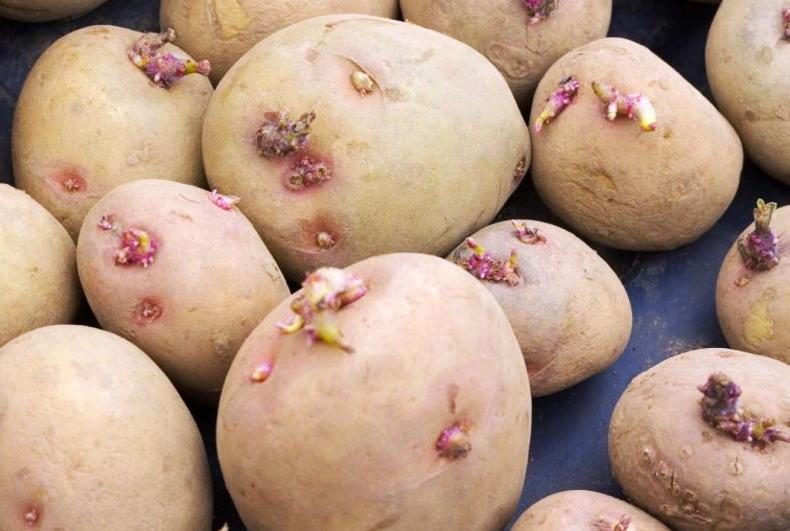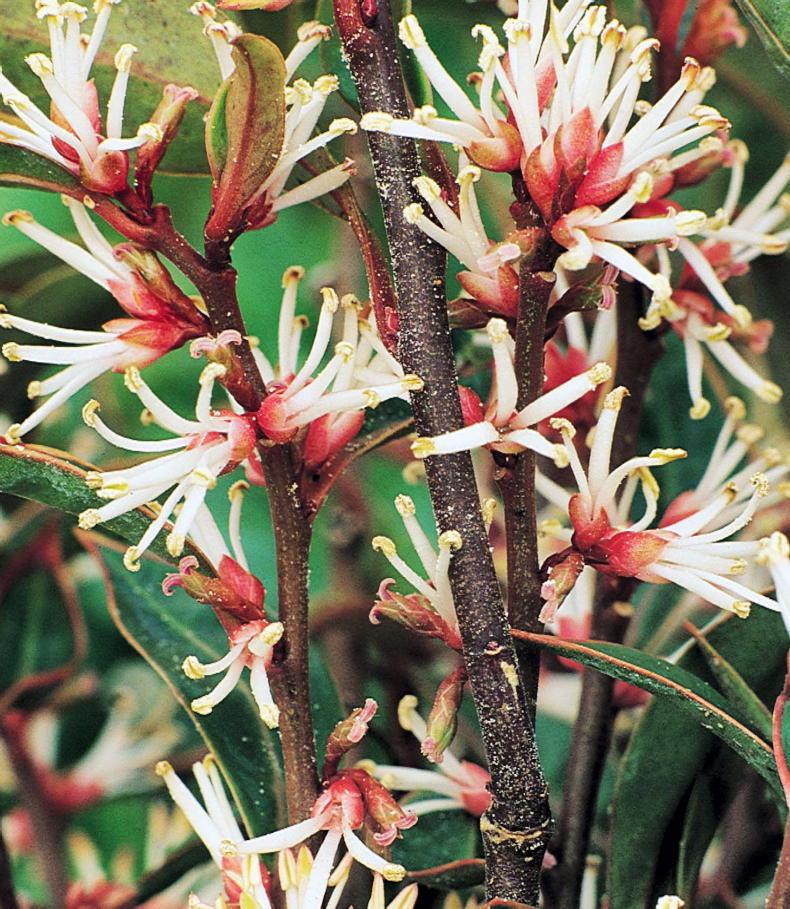Name: sweet box, Christmas box. The sweet box is also known as Christmas box, because it often begins to flower in late December. It carries the name box because it is part of the box family, which is used widely as a hedging plant. But this plant is not suitable for hedging because it spreads slowly by suckering and the hedge would simply creep outwards.
Botanical name: Its botanical name is Sarcococca hookeriana and the form of this species that is usually grown is Sarcococca hookeriana var. humilis. The ‘humilis’ part means that it is a low-growing form. The name sarco cocca means fleshy berry, a reference to the small, shiny, round black berries it produces. A very pretty variety is ’Purple Stem’, which is as the name suggests.
Garden value
The first inkling that there might be something attractive in the vicinity is a light waft of a sweet delicious scent.
Time and again, people will remark on it, look around to see what spectacular flower is producing this scent and soon give up when there is nothing showy to be seen.
Sweet box grows to about chest-height eventually, quite slowly, with the low-growing form being half that height. It is evergreen, like box, with narrow pointed leaves.
The flowers have no petals. Like many shrubs that depend on scent to attract pollinating bees, they have no need of showy petals.
The flowers consist only of style and stamens, and there is not very much to see.
The flowers are carried in the leaf axils along the twigs on the underside, which makes them hard to see but protects them, and the visiting bees, from the winter weather.
The stems can be brought indoors where they will last for a few days in water and release their sweet scent. The black berries follow the flowers but these are even more difficult to see.
Garden use
Sarcococca is not a star garden plant by any means but a place can be found for it in an out-of-the-way corner.
It is tolerant of shade and thrives with or without direct sunlight. In fact, it tends to burn out in too much sunshine. It grows in any soil that is not wet and it loves lots of leaf-mould in the soil, because it is a woodland plant in its native China. And it is good at keeping weeds down.
It is not the sort of plant that catches the eye, but its sweet perfume catches the attention of a delighted passer-by.
Early potatoes this year?

Chittting potatoes.
The supply of varieties for planting early was very scarce last year, so do not delay. Even a short row or two of new potatoes goes a long way. If you live in a mild part of the country, particularly in southern coastal areas, it is quite easy to grow really early potatoes successfully. Potatoes are highly susceptible to damage by frost. In a cold locality away from the coast, in northern areas, elevated ground or on the north side of hills, the chances are that it will be difficult to grow early potatoes successfully.
But in the mildest areas, planting can be done in February. It is beneficial to sprout or ‘chit’ the seed potatoes in a shed or greenhouse to encourage the formation of buds. A bright and fairly warm place is ideal. Seed potatoes with short green sprouts are ready as much as three weeks ahead of unchitted potatoes.
Varieties for use as first earlies include ‘Duke of York’, ‘Home Guard’, ‘Epicure’ and ‘Dunluce’. ‘Sharpe’s Express’ is low-cropping but of delicious flavour. Choose a sheltered spot for early potatoes with open, well-drained soil. When sowing chitted seed, it is worthwhile removing all but two or three of the sprouts to reduce the numbers of potatoes carried on each plant, allowing them to achieve good size more quickly.
Fruit, vegetables and herbs
The seed potatoes of early varieties can be planted during suitable weather. Check for damage to apple trees, pears and plums by bullfinches. These strip the fruit buds between now and April, and netting is the only remedy. Sow seeds of early vegetables under cover of glass.
Flowers
Bedding flowers can be started off from seeds in a heated propagator now, but it is still too early for most of the easy kinds. Watch for bulbs because they are now pushing through the soil and it is surprising how often they are walked on. Border flowers can be lifted and divided.
Lawn
Mow the grass if there is a suitable dry period when the ground is firm. Lawn moss was in active growth during the winter weeks and might need controlling with one of a number of products available for this purpose. Trim the edges if the grass has grown out.
Trees, shrubs and roses
Roses can be pruned at any time. Check all trees and shrubs planted last autumn for signs of wind-rocking. Check closely where the stem meets the ground. There might be rubbing and smoothing of the soil, and it is not unusual for water to gather there too.
Greenhouse and house plants
Check all greenhouse plants for pests such as red spider mites, mealy bugs and scale insects. These are persistent pests, difficult to get rid of, but they are at a low point now due to lower temperatures. Try to clear these pests before the new season’s growth really gets going.
Name: sweet box, Christmas box. The sweet box is also known as Christmas box, because it often begins to flower in late December. It carries the name box because it is part of the box family, which is used widely as a hedging plant. But this plant is not suitable for hedging because it spreads slowly by suckering and the hedge would simply creep outwards.
Botanical name: Its botanical name is Sarcococca hookeriana and the form of this species that is usually grown is Sarcococca hookeriana var. humilis. The ‘humilis’ part means that it is a low-growing form. The name sarco cocca means fleshy berry, a reference to the small, shiny, round black berries it produces. A very pretty variety is ’Purple Stem’, which is as the name suggests.
Garden value
The first inkling that there might be something attractive in the vicinity is a light waft of a sweet delicious scent.
Time and again, people will remark on it, look around to see what spectacular flower is producing this scent and soon give up when there is nothing showy to be seen.
Sweet box grows to about chest-height eventually, quite slowly, with the low-growing form being half that height. It is evergreen, like box, with narrow pointed leaves.
The flowers have no petals. Like many shrubs that depend on scent to attract pollinating bees, they have no need of showy petals.
The flowers consist only of style and stamens, and there is not very much to see.
The flowers are carried in the leaf axils along the twigs on the underside, which makes them hard to see but protects them, and the visiting bees, from the winter weather.
The stems can be brought indoors where they will last for a few days in water and release their sweet scent. The black berries follow the flowers but these are even more difficult to see.
Garden use
Sarcococca is not a star garden plant by any means but a place can be found for it in an out-of-the-way corner.
It is tolerant of shade and thrives with or without direct sunlight. In fact, it tends to burn out in too much sunshine. It grows in any soil that is not wet and it loves lots of leaf-mould in the soil, because it is a woodland plant in its native China. And it is good at keeping weeds down.
It is not the sort of plant that catches the eye, but its sweet perfume catches the attention of a delighted passer-by.
Early potatoes this year?

Chittting potatoes.
The supply of varieties for planting early was very scarce last year, so do not delay. Even a short row or two of new potatoes goes a long way. If you live in a mild part of the country, particularly in southern coastal areas, it is quite easy to grow really early potatoes successfully. Potatoes are highly susceptible to damage by frost. In a cold locality away from the coast, in northern areas, elevated ground or on the north side of hills, the chances are that it will be difficult to grow early potatoes successfully.
But in the mildest areas, planting can be done in February. It is beneficial to sprout or ‘chit’ the seed potatoes in a shed or greenhouse to encourage the formation of buds. A bright and fairly warm place is ideal. Seed potatoes with short green sprouts are ready as much as three weeks ahead of unchitted potatoes.
Varieties for use as first earlies include ‘Duke of York’, ‘Home Guard’, ‘Epicure’ and ‘Dunluce’. ‘Sharpe’s Express’ is low-cropping but of delicious flavour. Choose a sheltered spot for early potatoes with open, well-drained soil. When sowing chitted seed, it is worthwhile removing all but two or three of the sprouts to reduce the numbers of potatoes carried on each plant, allowing them to achieve good size more quickly.
Fruit, vegetables and herbs
The seed potatoes of early varieties can be planted during suitable weather. Check for damage to apple trees, pears and plums by bullfinches. These strip the fruit buds between now and April, and netting is the only remedy. Sow seeds of early vegetables under cover of glass.
Flowers
Bedding flowers can be started off from seeds in a heated propagator now, but it is still too early for most of the easy kinds. Watch for bulbs because they are now pushing through the soil and it is surprising how often they are walked on. Border flowers can be lifted and divided.
Lawn
Mow the grass if there is a suitable dry period when the ground is firm. Lawn moss was in active growth during the winter weeks and might need controlling with one of a number of products available for this purpose. Trim the edges if the grass has grown out.
Trees, shrubs and roses
Roses can be pruned at any time. Check all trees and shrubs planted last autumn for signs of wind-rocking. Check closely where the stem meets the ground. There might be rubbing and smoothing of the soil, and it is not unusual for water to gather there too.
Greenhouse and house plants
Check all greenhouse plants for pests such as red spider mites, mealy bugs and scale insects. These are persistent pests, difficult to get rid of, but they are at a low point now due to lower temperatures. Try to clear these pests before the new season’s growth really gets going.







 This is a subscriber-only article
This is a subscriber-only article










SHARING OPTIONS: